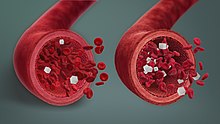| Hypoglycemia | |
|---|---|
| Other names | Hypoglycaemia, hypoglycæmia, low blood glucose, low blood sugar |
 | |
| Hypoglycemia (left) and normal blood sugar concentration (right) | |
| Specialty | Endocrinology |
| Symptoms | Headache, blurred vision, shakiness, dizziness, weakness, fatigue, sweating, clamminess, fast heart rate, anxiety, hunger, nausea, pins and needles sensation, difficulty talking, confusion, unusual behavior, lightheadedness, pale skin color, seizures[1][2][3][4][5] |
| Complications | Loss of consciousness, death |
| Usual onset | Rapid[1] |
| Causes | Medications (insulin, glinides and sulfonylureas), sepsis, kidney failure, certain tumors, liver disease[1][6] |
| Diagnostic method | Whipple's triad: Symptoms of hypoglycemia, serum blood glucose level <70 mg/dL (3.9 mmol/L), and resolution of symptoms when blood glucose returns to normal[2] |
| Treatment | Eating foods high in simple sugars |
| Medication | Glucose, glucagon[1] |
| Frequency | In type 1 diabetics, mild hypoglycemia occurs twice per week on average, and severe hypoglycemia occurs once per year.[3] |
| Deaths | In type 1 diabetics, 6–10% will die of hypoglycemia.[3] |
Hypoglycemia (American English), also spelled hypoglycaemia or hypoglycæmia (British English), sometimes called low blood sugar, is a fall in blood sugar to levels below normal, typically below 70 mg/dL (3.9 mmol/L).[1][3] Whipple's triad is used to properly identify hypoglycemic episodes.[2] It is defined as blood glucose below 70 mg/dL (3.9 mmol/L), symptoms associated with hypoglycemia, and resolution of symptoms when blood sugar returns to normal.[1] Hypoglycemia may result in headache, tiredness, clumsiness, trouble talking, confusion, fast heart rate, sweating, shakiness, nervousness, hunger, loss of consciousness, seizures, or death.[1][3][2] Symptoms typically come on quickly.[1]
The most common cause of hypoglycemia is medications used to treat diabetes such as insulin, sulfonylureas, and biguanides.[3][2][6] Risk is greater in diabetics who have eaten less than usual, recently exercised, or consumed alcohol.[1][3][2] Other causes of hypoglycemia include severe illness, sepsis, kidney failure, liver disease, hormone deficiency, tumors such as insulinomas or non-B cell tumors, inborn errors of metabolism, and several medications.[1][3][2] Low blood sugar may occur in otherwise healthy newborns who have not eaten for a few hours.[7]
Hypoglycemia is treated by eating a sugary food or drink, for example glucose tablets or gel, apple juice, soft drink, or lollies.[1][3][2] The person must be conscious and able to swallow.[1][3] The goal is to consume 10–20 grams of a carbohydrate to raise blood glucose levels to a minimum of 70 mg/dL (3.9 mmol/L).[3][2] If a person is not able to take food by mouth, glucagon by injection or insufflation may help.[1][3][8] The treatment of hypoglycemia unrelated to diabetes includes treating the underlying problem.[3][2]
Among people with diabetes, prevention starts with learning the signs and symptoms of hypoglycemia.[3][2] Diabetes medications, like insulin, sulfonylureas, and biguanides can also be adjusted or stopped to prevent hypoglycemia.[3][2] Frequent and routine blood glucose testing is recommended.[1][3] Some may find continuous glucose monitors with insulin pumps to be helpful in the management of diabetes and prevention of hypoglycemia.[3]
- ^ a b c d e f g h i j k l m n National Institute of Diabetes and Digestive and Kidney Diseases (NIDDK). "Low Blood Glucose (Hypoglycemia)". NIDDK.nih.gov. Archived from the original on 28 July 2017. Retrieved 12 January 2022.
- ^ a b c d e f g h i j k l Cryer PE, Axelrod L, Grossman AB, Heller SR, Montori VM, Seaquist ER, Service FJ (March 2009). "Evaluation and management of adult hypoglycemic disorders: an Endocrine Society Clinical Practice Guideline". The Journal of Clinical Endocrinology and Metabolism. 94 (3): 709–728. doi:10.1210/jc.2008-1410. PMID 19088155.
- ^ a b c d e f g h i j k l m n o p q Jameson JL, Kasper DL, Longo DL, Fauci AS, Hauser SL, Loscalzo J (2018). Harrison's principles of internal medicine (20th ed.). New York. ISBN 978-1-259-64403-0. OCLC 1029074059. Archived from the original on 29 August 2021. Retrieved 12 January 2022.
{{cite book}}: CS1 maint: location missing publisher (link) - ^ Cite error: The named reference
Young_2016was invoked but never defined (see the help page). - ^ American Diabetes Association (ADA). "Hypoglycemia (Low Blood Glucose)". www.diabetes.org. Archived from the original on 13 January 2022. Retrieved 12 January 2022.
- ^ a b Yanai H, Adachi H, Katsuyama H, Moriyama S, Hamasaki H, Sako A (February 2015). "Causative anti-diabetic drugs and the underlying clinical factors for hypoglycemia in patients with diabetes". World Journal of Diabetes. 6 (1): 30–36. doi:10.4239/wjd.v6.i1.30. PMC 4317315. PMID 25685276.
- ^ Cite error: The named reference
:7was invoked but never defined (see the help page). - ^ "FDA approves first treatment for severe hypoglycemia that can be administered without an injection". FDA. 11 September 2019. Archived from the original on 17 May 2020. Retrieved 11 November 2019.